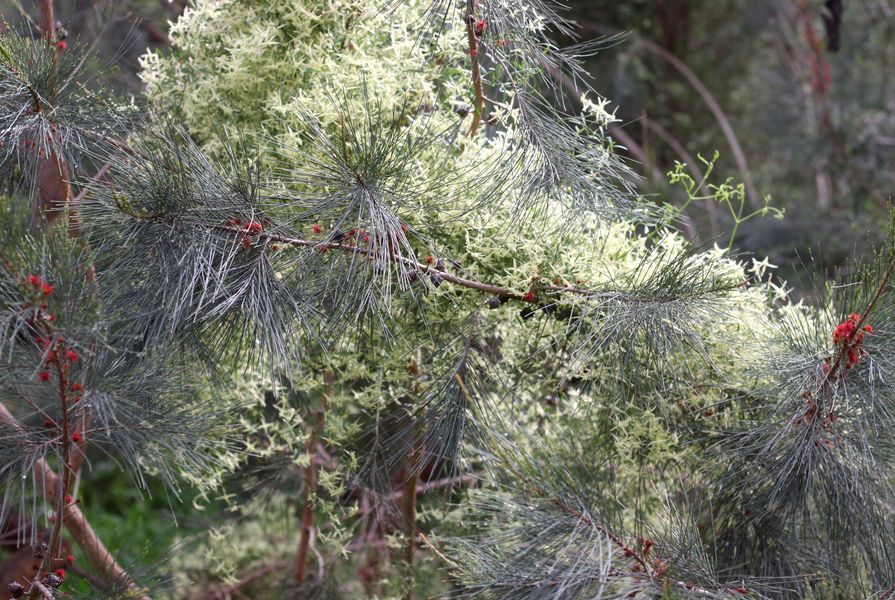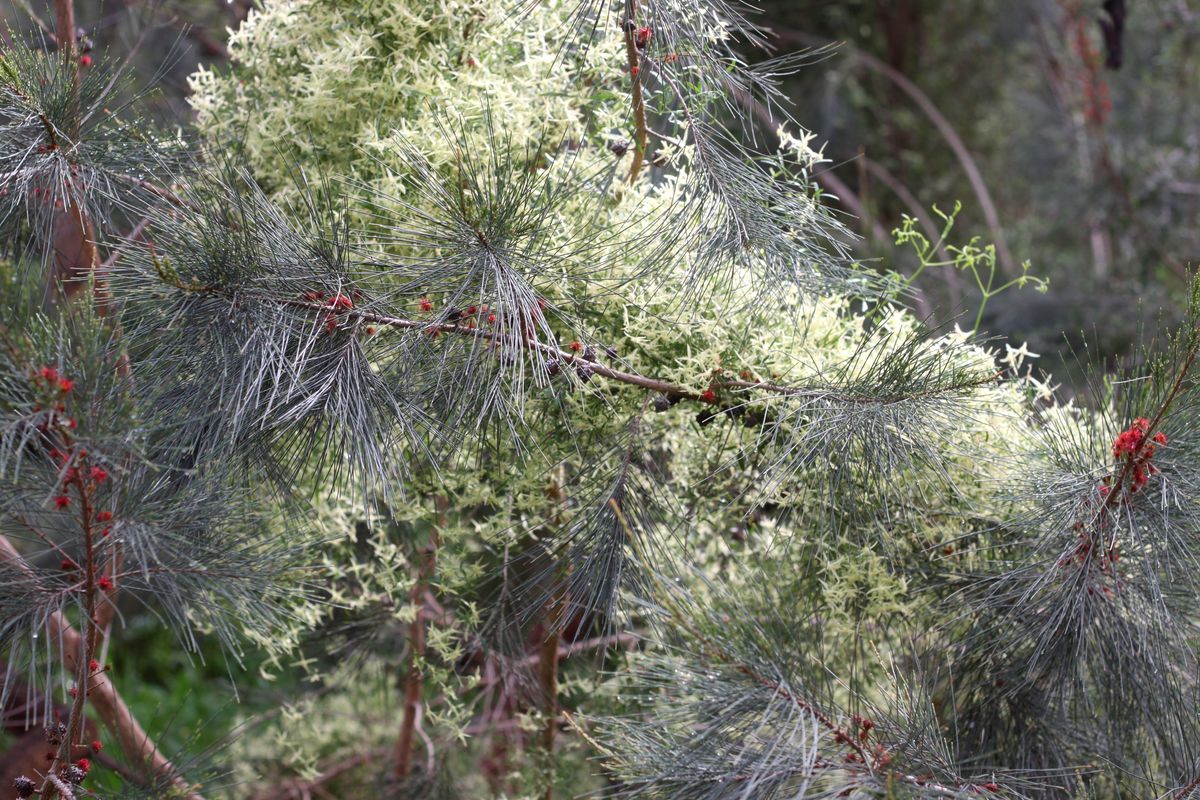Ecological succession can be defined as any landscape’s evolution from disturbance. These disturbances can range from extreme events, such as fire or deforestation, to more subtle activities like grazing or mowing. Many Australian bush landscapes are successional ecologies in different stages. The use of firestick farming by Indigenous peoples for more than sixty thousand years had privileged open canopy plant communities with monocot-dominated understoreys in many parts of Australia. Historic accounts of the landscapes around Melbourne, western Sydney and Tasmania show how quickly succession from grassland to forest occurred without the regular disturbance of fire.
Australia has many colonizing species – these are the first to germinate after a disturbance, particularly fire (the germination of many species is triggered by the chemicals in smoke). An interesting case study is what occurred in 1991 in the Long Hollow Heathland in Beaumaris, Victoria – a small area of remnant vegetation surrounded by housing. The original ecological vegetation class was coastal heathland, but in the absence of fire it had become a monoculture of Leptospermum laevigatum (native coastal tea-tree). Firebugs lit a fire and the result was astounding; the vegetation changed from one to three species per square metre (Leptospermum laevigatum has a closed canopy and very few species can grow on the ground plane) to fifteen to twenty species, some of which had been locally extinct since the 1930s. This case study is particularly interesting because it demonstrates how many Australian ecosystems have evolved from regular extreme disturbances. These are incredibly dynamic landscapes from which we can draw inspiration as designers.
Many of the first species to appear after disturbance have remarkable nursing abilities: deep taproots to survive exposed soils and to bring minerals from the subsoil to the surface, rapid growth to shade the ground plane and a short life, resulting in accelerated levels of organic matter returning to the soil. Many of the species fix nitrogen to the soil; Australia has a large range of nitrogen fixers, including our national floral emblem, Acacia pycnantha (golden wattle).
In an area of bushland four kilometres from Melbourne’s CBD, a beautiful phenomenon of ecological succession can be witnessed. Acacia pycnantha trees are growing in abundance on the eastern bank of the Yarra River, and most of them are on the brink of senescence. For the past twenty years the Acacia pycnantha have been fixing nitrogen and reducing evaporation rates at the site, which has helped the taprooted Clematis microphylla (small-leaved clematis) become the next player in the successional ecology. The Acacia pycnantha trees that have died have fostered this relationship, and they now look like floating clouds of the palest cream green in the most fantastical shapes. One of the qualities that make this landscape so exceptional is that the dead trees are as beautiful and integral to the landscape condition as the floriferous and fragrant clematis.
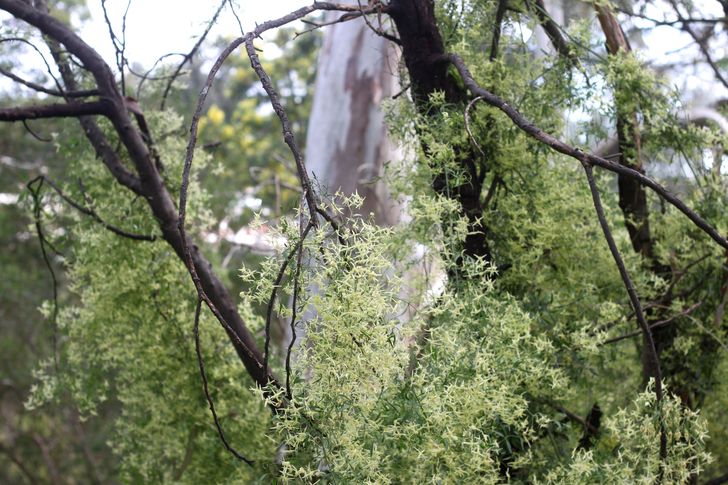
A dead Acacia Pycnantha provides a beautiful structure for the creeping Clematis microphylla to grow over.
Image: Gareth Pollock
The New Wave planting movement demonstrates an appreciation of the cycles of life in exotic perennial plants. Piet Oudolf is quoted as saying, “The skeletons of the plants are for me as important as the flowers,” (Sally McGrane, “A Landscape in Winter, Dying Heroically,” The New York Times , 31 January 2008). However, when it comes to experimenting with Australian native plants, we are yet to see this appreciation in the public realm. There are many exciting opportunities that short-lived woody vegetation can provide us within its deceased forms. In the dry areas of Australia, decomposition is incredibly slow – an Acacia pycnantha can last in its deceased form for many years due to the dry environments in which it grows. It has a tendency to distort itself into fascinating contorted forms, sometimes seeming to fight the plant hormone auxin and to decide to grow toward the earth rather than the sun, which results in some amazing shapes after it has died.
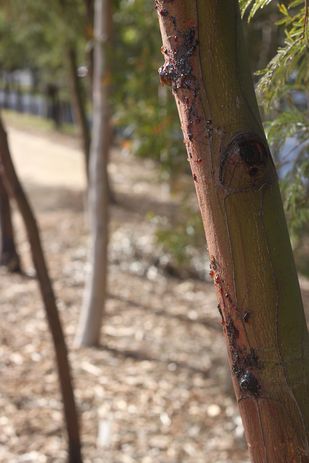
The Acacia mearnsii planted Royal Park around late 2014 are already showing signs of insect damage, which contributes to the tree’s short lifespan.
Image: Gareth Pollock
Many lessons can be learnt by examining the way successional ecologies work and these can be applied to alternate management regimes in urban environments. Rather than humans being the primary maintenance mechanism, we can start to use passive maintenance through environmental manipulation and an understanding of succession. This has been achieved with much nuance and skill at the Nature Play at Royal Park playspace, designed by the City of Melbourne’s City Design Studio. Along the Gatehouse Street boundary there are dense plantings of locally indigenous eucalypts (Eucalyptus polyanthemos, Eucalyptus melliodora and Eucalyptus camaldulensis) that are interplanted with Acacia mearnsii (black wattle). This is highly unusual to see in an urban planting scheme and a very clever strategy for many reasons. The Acacia mearnsii will grow at a faster rate than the eucalypts, shading them and thus reducing evaporation on the ground. The faster rate of growth will also encourage the eucalypts to grow tall and straight to gain access to light. When trees grow vertically and rapidly due to light competition they tend to develop fewer lateral branches and are faster to discard any that they do develop.
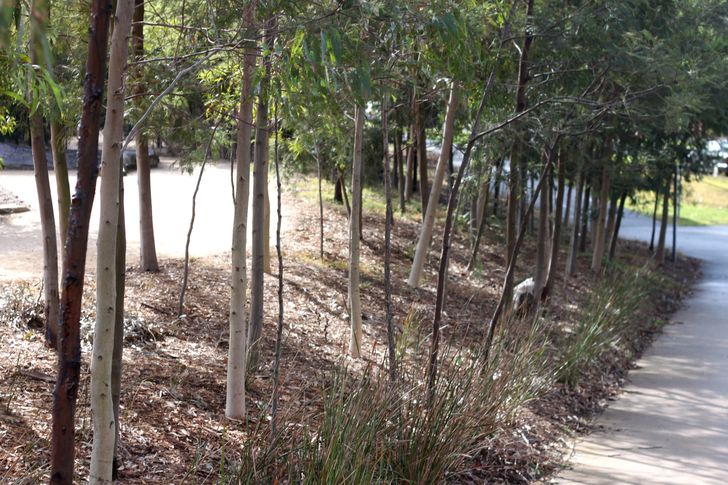
At Nature Play at Royal Park, short-lived, fast-growing Acacia mearnsii have been interplanted with various eucalyptus species to encourage a faster growth rate and more upright form.
Image: Gareth Pollock
Training trees through successional planting makes perfect economic sense. Each tree that is planted must be maintained by the council, requiring initial irrigation, regular inspection and pruning to shape. But any reduction in the maintenance regime would in turn decrease the budget required, which could be redirected into planting more trees or increasing the maintenance of parklands beyond the typical slash-and-spray regime.
Rapid growth, taproots and nitrogen fixing are traits that colonizing plants share globally. The urban landscape condition is one of continual disturbance so it is not surprising that colonizing species thrive in these environments – we refer to them as weeds. The irony of our battle against weeds is that we re-create disturbance every time we attempt to eradicate them. In northern New South Wales a prevalent weed is a cultivar of Lantana camara (lantana); it invades old pastures and ex-banana plantations. Initially it swamps everything, creating a monoculture infested with ticks, but over twenty years it keeps “building” upon itself, creating an open ground plane beneath that is totally shaded. Lantana is a nitrogen fixer so the soil becomes enriched over time. Many rainforest species need a similar environment to the rainforest floor in order to germinate, which the lantana creates. The rainforest trees eventually grow through the lantana and when the canopies become full, the environment becomes too shaded for the lantana to grow.
When we think of vegetated landscapes as processes rather than objects, we can re-examine the role of maintenance. Anyone who has tended a garden knows that maintenance is ultimately what leads to the success of any design, but maintenance need not be manifested in the current ways. By using ecological succession practices, we can act as choreographers in the landscape rather than prison wardens constantly attempting in vain to control vegetation. Time and subtlety do not necessarily make for sexy drone shots, but they do create working, dynamic and resilient landscapes.
Source

Practice
Published online: 27 Feb 2018
Words:
Alistair Kirkpatrick
Images:
Gareth Pollock
Issue
Landscape Architecture Australia, November 2017

